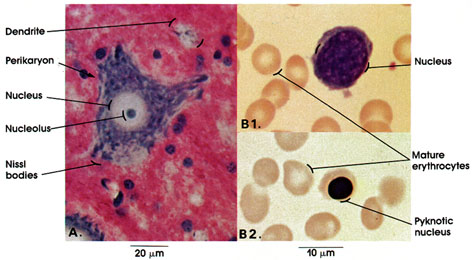

A. Motor neuron
B1. Basophilic & B2. Orthochromatic erythroblasts
Ronald A. Bergman, Ph.D., Adel K. Afifi, M.D., Paul M. Heidger,
Jr., Ph.D.
Peer Review Status: Externally Peer Reviewed
A. Motor neuron
B1. Basophilic & B2. Orthochromatic erythroblasts

The fact that nuclei of certain cells differ in appearance and staining properties can be directly related to nuclear function. Compare the appearance of the functionally active nucleus of the motor neuron with that of the functionally inactive nucleus of the maturing red blood cell.
A: This figure shows a motor neuron characterized by a multipolar perikaryon, cytoplasm rich in Nissl bodies (ribonucleoproteins), and a stout dendrite, which can be identified because it is structurally similar to the cell body from which it arises. The nucleus, centrally placed within the cell body, is spherical and unstained (contains euchromatin) and has a prominent densely staining basophilic nucleolus rich in ribonucleic acid. This cell body is located within the spinal cord, but its elongated axon leaves the cord to terminate on striated skeletal muscle fibers.
B1: This figure shows a basophilic erythroblast (also known as a prorubricyte), one of the early cells in the development of the red blood corpuscle. Note that the nucleus occupies a significant portion of the cell and that its stainable inactive chromatin is coarse. A nucleolus is present but obscured by stainable heterochromatin. The cytoplasm of this cell contains ribonucleic acid, giving it a lavender hue. Compare the cytoplasm of this cell with a mature non-nucleated red blood cell.
B2: This figure shows the small pyknotic nucleus of an orthochromatic erythroblast. This cell is also known as a metarubricyte or a normoblast. The chromatin (heterochromatin) is very compact and densely stained. Such a nucleus is functionless and is ultimately discarded, resulting in a mature non-nucleated erythrocyte.
*Wright, 1871 -1928, was an American pathologist.
Next Page | Previous Page | Section Top | Title Page
Please send us comments by filling out our Comment Form.
All contents copyright © 1995-2025 the Author(s) and Michael P. D'Alessandro, M.D. All rights reserved.
"Anatomy Atlases", the Anatomy Atlases logo, and "A digital library of anatomy information" are all Trademarks of Michael P. D'Alessandro, M.D.
Anatomy Atlases is funded in whole by Michael P. D'Alessandro, M.D. Advertising is not accepted.
Your personal information remains confidential and is not sold, leased, or given to any third party be they reliable or not.
The information contained in Anatomy Atlases is not a substitute for the medical care and advice of your physician. There may be variations in treatment that your physician may recommend based on individual facts and circumstances.
URL: http://www.anatomyatlases.org/